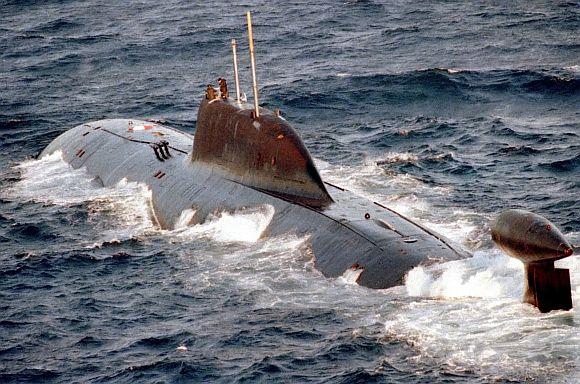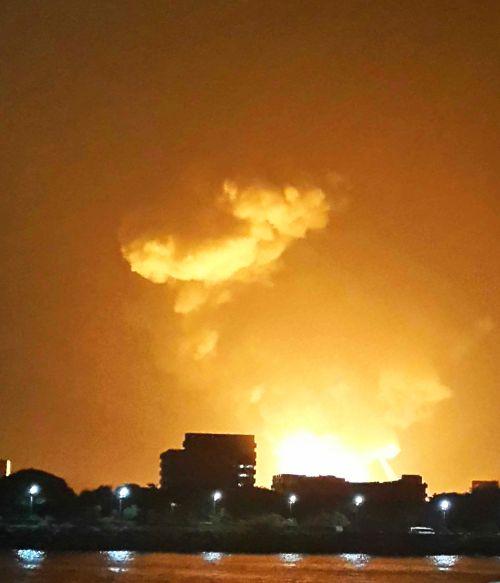Photographs: Defence PRO
India lost its frontline submarine on Wednesday in a blaze. This comes at a time when India is planning to phase out older class of submarines by next year. For the next few years then, the edge enjoyed by the Indian Navy in underwater capabilities with respect to Pakistan stands significantly reduced, says Colonel Ashwani Gupta.
The loss of Kilo class submarine INS Sindhurakshak (Sea Protector) due to an onboard explosion and the partial damage to another submarine due to resultant fire has reduced India’s Kilo Class submarine fleet to nine.
Manufactured by Russia and commissioned on Dec 24, 1997, the submarine underwent a two-year refit and upgradation at the Zvezdochka shipyard and returned to India on 29 April this year. The upgrade fitted the submarine with the latest weapon systems and extended its life by 10 years.
INS Sindhurakshak had a displacement of 3,000 tonnes, a top speed of 18 knots and was capable of operating solo for 45 days with a crew of 53. This was the second accident on INS Sindhurakshak, which led to the total loss of the submarine and the even more tragic loss of 18 precious lives.
...
Sabotage as a cause has been ruled out
Image: The vessel underwent a revamp in Russia recentlyPhotographs: Indian Embassy in Russia/K R Deepak
The earlier accident had taken place on February 26, 2010 due to a faulty battery leading to death of one sailor and injuries to two others. Soon after, the submarine had gone to Russia for extensive refits. The kilo class submarines have diesel electric propulsion and the charging of batteries is of utmost importance before heading off to sea.
The cause of the explosion is not known, though sabotage as a cause has been ruled out. Some reports however suggest that the explosion in the submarine was possibly caused due to accidental detonation in the torpedo bay due to the accumulation of hydrogen gas in the battery compartment.
As the battery compartment is located just below the weapon bay, the damage has been extensive. A board of inquiry has been constituted to look into tragic incident which will give its report in a month. Hopefully, the cause will be identified to prevent recurrence of such accidents in future.
The Sindhurakshak was part of the Sindhughosh class, the premier kilo class submarines operated by the Indian Navy. Eight out of the 10 Sindhughosh class submarines have been upgraded with latest weaponry, sonars and electronic warfare systems to make them fit to serve for another 10 to 15 years.
As part of operation tasking, the upgraded submarines are required to patrol in designated areas of the ocean, escort own assault warships and engage enemy submarines and surface targets.
...
The Indian Navy however has on order
Image: File image of a Russian Akula-II class 'Nerpa' nuclear attack submarineFitted with the latest Club-S multi-role missile system, Sindhurakshak was capable of engaging targets at a distance of over 250 km. Hence, the complete loss of one submarine and partial damage to another will undermine Indian Navy’s efforts to that extent. It must also be noted that some older class of submarines like Russian Kilo class and German HDW Type 209 are planned to be phased out next year as per a report published in the Hindustan Times.
The navy currently has 14 submarines in service though the viable available strength would be much less after taking into account the operational availability. In contrast, China has about 45 submarines and Pakistan has nine. With reduction of the available operational submarines, the Indian submarine arm will be reduced to the size of Pakistan’s submarine fleet.
For the next few years then, the edge enjoyed by the Indian Navy in underwater capabilities with respect to Pakistan stands significantly reduced.
The Indian Navy however has on order, six Scorpene class submarines (diesel electric submarines from France) and two Akula class submarines (Nuclear powered submarines from Russia). The first Scorpene class submarine is likely to be inducted in 2016 and will coincide with addition of the aircraft carrier, Admiral Gorshkov.
...
Weak regulatory systems will only lead to more accidents
Image: A view of the flames from the burning Indian Navy submarine INS Sindhurakshak in Mumbai on last Tuesday nightPhotographs: Vikalp Shah/Reuters
The indigenous nuclear powered submarine, INS Arihant is presently in trial stages and is a few years away from an operational deployment. In the meantime, China is planning to add 15-16 new submarines in its fleet. The loss of Sindhurakshak is hence a huge setback for India in the short term. It will take about a decade to have a potent deterrent submarine arm in place.
While the board of inquiry ordered to look into the accident is proceeding with its work, the time is perhaps appropriate to have a re-look at all our safety procedures and systems. The naval chief stated on television the possibility that “safety mechanisms have not functioned”.
This is indeed disturbing, as the submarine had recently come back from Russia after an extensive and expensive refit. For safety mechanisms to fail throws up much larger concerns of the health of the entire submarine fleet. A de novo look must now be taken on all our procedures, which declare a ship seaworthy.
Such certification must be done with due diligence, holding the certifying authorities liable for the same. Not just the Navy but the army and the air force too need to look into safety issues with respect to the equipment held by them.
The role and functioning of the directorate general quality assurance needs to be looked into and its leadership held accountable for the certification of goods purchased by the armed forces. Weak regulatory systems will only lead to more accidents and tremendous cost in precious lives and equipment as well as affecting the operational readiness of the armed forces.
The author is a Senior Fellow at Centre for Land Warfare Studies
Views expressed are personal





article